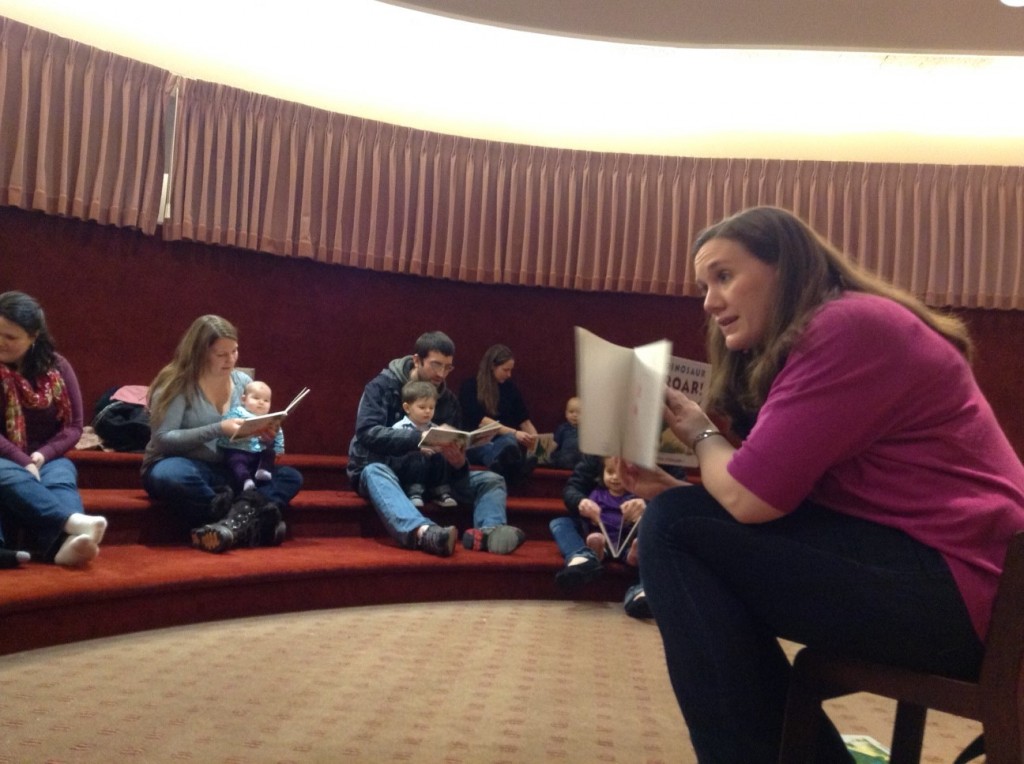
Click to listen to the full audio story:
early literacy final
Elizabeth Nicolai is the Youth Services Coordinator for the Loussac Library, and right now she’s reading a dinosaur book to a group of very small children.
Recently the library expanded their second floor to include what they call the Play and Learn center. “You see tons of books right at child level, you can see parents and kids reading together, which is so much fun,” Nicolai says.
But the learning center involves much more than reading. Inside of what looks like a massive fort of books there are toys, inspirational messages, and interactive art work on the walls. Nicolai says this is because early literacy is complex.
“The first job a child has is playing. When a child plays they’re exploring the social roles, the fine and gross motor skills they’ll need their entire life and they’re learning verbal language and interactive cues. So while it looks like just tables, benches and a bunch of toys, everything is really carefully selected to help children develop early literacy skills and early learning skills for the rest of their life,” Nicolai says.
The emphasis at the Loussac is still books though. After all, this is a library. Nicolai says reading at an early age is more important than most people realize, and that the library wants to do its part to combat low preschool enrollment and poor high school graduation rates in Alaska.
“Far too often people aren’t aware of where their child should be, or how to prepare their child. So when they come into kindergarten, unless they’ve been in a head start program or preschool they’re faced with educational norms that they may not be prepared for,” Nicolai says.
And Nicolai says the simplest thing you can do is read to your child. As much as possible.

“Studies have shown that if your child is exposed to 500-1000 books before they reach kindergarten; it’s the same educational advantage as growing up in a house with two parents with masters degrees. Now obviously, most people can’t afford 500-1000 books. And you don’t have to! That’s why we have a library,” Nicolai says.
Now, you might be thinking ‘I could just download that many books for little to no cost on my iPad or Kindle, especially over five years right?’ Nicolai says you could, but letting your child use an e-reader can be a slippery slope.
“It looks like a solid light to you, but the American Pediatric Association says it’s a pulsing light, and we don’t know what that does to developing brains. Children develop all of their brain connections in those first three years of life,” Nicolai says.
It turns out, when small children use a tablet device they generally focus more on the screen and less on the person reading, limiting interaction; another important early literacy skill. She isn’t anti e-reader though, and says you can even check out digital books through the Loussac.
In addition to the new Play and Learn center, the Loussac has also expanded it’s ready to read resource center, which is a space on the 4th floor filled with stacks and stacks of plastic totes.
“We have hundreds of these tubs. As you can see it’s about 5,000 square feet of space dedicated to storing early literacy materials,” Nicolai says.
These totes are shipped out all across the state, and are treated much like a single library book. You check one out, you return it, you get another one. I ask Nicolai to pop one open.
“Its got tons of board books and paper backs, and it always comes with resources for adults. When we send out bags and resources for kids it’s always fun for us to send out something for the adult in their lives,” Nicolai says.
Things like activity ideas, and tools to assess your child’s literacy progress. Nicolai encourages those who don’t have access to libraries to utilize the ready to read totes, but for those close-by Alaskans, she says an adventure to the Loussac is pretty hard to beat.
“I heard someone describe Loussac as Anchorage’s living room, and I love that description. We want to be a place for the community to gather, and learn, and explore, and discover together.”
Dave Waldron began his radio career in 2000 as a volunteer DJ at UAA’s radio station KRUA 88.1, where he hosted a weekend music show. In 2004 he was hired as the station’s music director, and held the position until his graduation in 2007. He was hired by Alaska Public Media in 2008 and since then has worked as an audio engineer, editor, and producer. He currently runs his own small business AK Audio Pro, and is a host of Alaska Public Media’s Hometown, Alaska.





